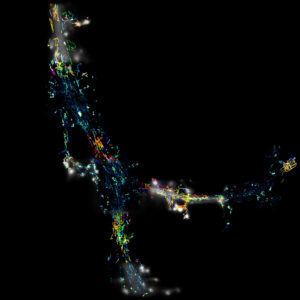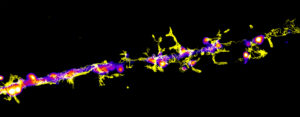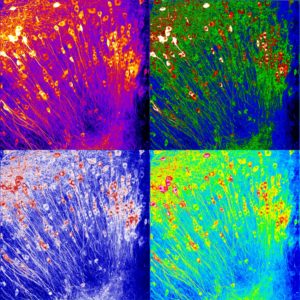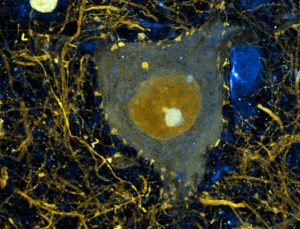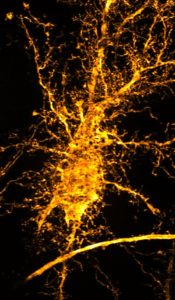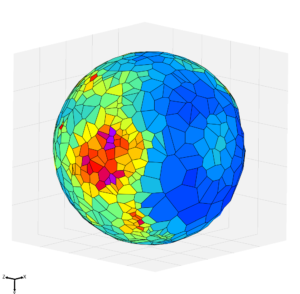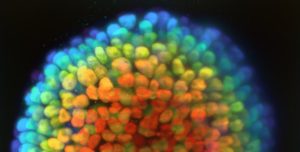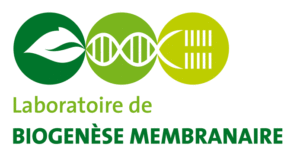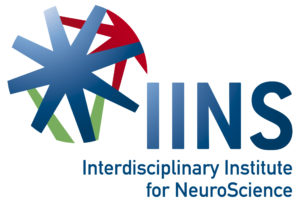Representation of PALM technology on a rat hippocampal neuron. The low resolution image corresponds to the synaptic marker, Homer-GFP. Using PALM superresolution technology, it is possible to visualise NMDAR trafficking and clusters in high resolution. This approach can be used in the study of autoimmune neuropsychiatric diseases that disrupt both the organisation of NMDAR and their diffusion at the neuronal surface.
Neuronal spheroids of rat primary neurons are grown in hydrogel templates. The cells are electroporated with GFP and tdtomato. Then the spheroids are fixed and imaged with a confocal microscope. Cells in 3D structure mimic better functions and morphology properties of in vivo.
The image shows the movements of Dopamine Receptors at the surface of hippocampal neurons and was acquired on a spinning disk. We took 1000 frames at 50ms exposition before reconstructing the trajectories of single receptors with PalmTracer. This allow us to understand, down to the nanometric scale, how the interaction between receptors modulate their surface diffusion.
Microscopy technique: single particle tracking, spinning disk microscopy
Patchwork of 4 maximum projections with different LUTs of a z-stack acquired in 2-photon microscopy. Neurons express the GCaMP6f calcium sensor following a viral infection of an organotypic mouse brain slice.
Hippocampal neurons from organotypic slices receiving inputs from GFP-labeled neurons (in yellow). Pan-Expansion microscopy allows to increase the resolution 4 folds and to obtain an ultrastructural context of the whole brain (in blue).
Astrocyte labeled by electroporation expressing a free cytosolic fluorescent protein (GFP) inside a fixed mouse hippocampal organotypic brain slice. A neuronal dendrite is also labeled and visible at the bottom of the image. Maximum intensity projection of a 40x70x100 µm3 volume. 3D deconvolution with in situ PSF. Sample preparation done by Monica Fernandez-Monreal.
Microscopy technique: Lattice Light Sheet Microscopy
PD1 membrane receptors super-resolution imaging in a PD1 stably expressing Jurkat cell. This acquisition has been performed with our soSPIM (single-objective Selective Plane Illumination Mocroscopy) system combined with an Adaptive Optics system (MicAO, Imagine Optique). The whole volume is composed of 35 Z-sections acquired every 500 nm, with each section consisting of 22,500 frames for a total acquisition time of 13h handled fully automatically. On each frame every molecule was precisely localized in 3D through an astigmatism-based process. The final cell exhibited more than 300,000 localizations and was 10 µm wide. To assess the spatial organization of clusters on the cell membrane, we used their centroids to compute a Voronoi diagram on the sphere approximating the cell shape.
Microscopy technique: In depth light-sheet based single-molecule localization microscopy
Rat hippocampal neuron filled with a fluorescent marker and observed by dSTORM. The image shows details of dendritric spine morphology as well as surrounding axons in which we can observe the membrane-associated periodic skeleton.
